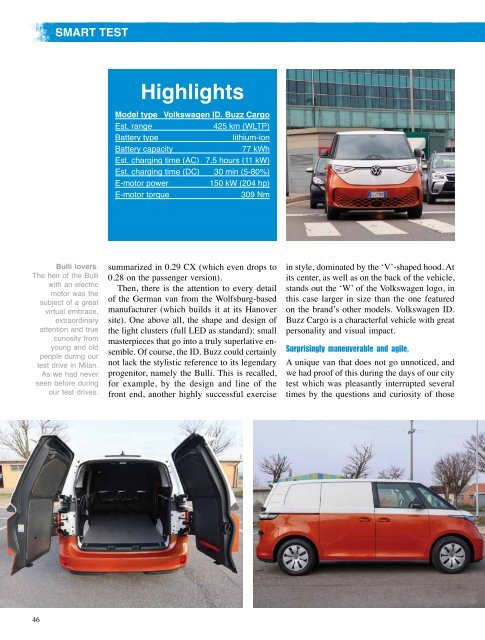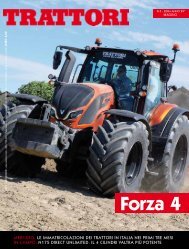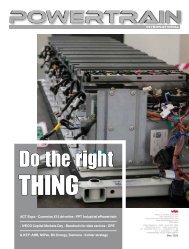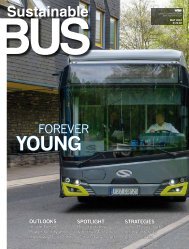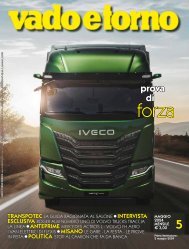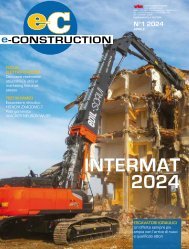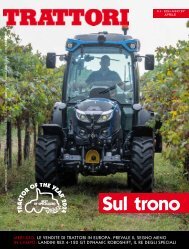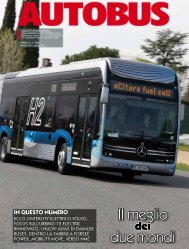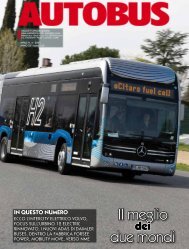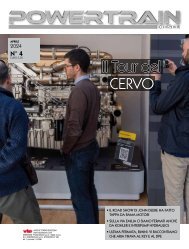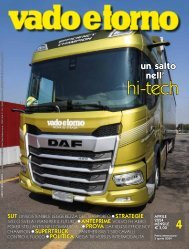2023_11_Sustainable Truck&Van
Create successful ePaper yourself
Turn your PDF publications into a flip-book with our unique Google optimized e-Paper software.
SMART TEST<br />
Bulli lovers.<br />
The heir of the Bulli<br />
with an electric<br />
motor was the<br />
subject of a great<br />
virtual embrace,<br />
extraordinary<br />
attention and true<br />
curiosity from<br />
young and old<br />
people during our<br />
test drive in Milan.<br />
As we had never<br />
seen before during<br />
our test drives.<br />
Highlights<br />
Model type Volkswagen ID. Buzz Cargo<br />
Est. range<br />
425 km (WLTP)<br />
Battery type<br />
lithium-ion<br />
Battery capacity<br />
77 kWh<br />
Est. charging time (AC) 7,5 hours (<strong>11</strong> kW)<br />
Est. charging time (DC) 30 min (5-80%)<br />
E-motor power<br />
150 kW (204 hp)<br />
E-motor torque<br />
309 Nm<br />
summarized in 0.29 CX (which even drops to<br />
0.28 on the passenger version).<br />
Then, there is the attention to every detail<br />
of the German van from the Wolfsburg-based<br />
manufacturer (which builds it at its Hanover<br />
site). One above all, the shape and design of<br />
the light clusters (full LED as standard): small<br />
masterpieces that go into a truly superlative ensemble.<br />
Of course, the ID. Buzz could certainly<br />
not lack the stylistic reference to its legendary<br />
progenitor, namely the Bulli. This is recalled,<br />
for example, by the design and line of the<br />
front end, another highly successful exercise<br />
in style, dominated by the ‘V’-shaped hood. At<br />
its center, as well as on the back of the vehicle,<br />
stands out the ‘W’ of the Volkswagen logo, in<br />
this case larger in size than the one featured<br />
on the brand’s other models. Volkswagen ID.<br />
Buzz Cargo is a characterful vehicle with great<br />
personality and visual impact.<br />
Surprisingly maneuverable and agile,<br />
A unique van that does not go unnoticed, and<br />
we had proof of this during the days of our city<br />
test which was pleasantly interrupted several<br />
times by the questions and curiosity of those<br />
who flanked the vehicle. What stands out, more<br />
than the 4,712 millimeters in length and the<br />
2,989 millimeters in wheelbase, are the very<br />
short overhangs (820 millimeters at the front<br />
only, 903 millimeters at the rear), which, together<br />
with the <strong>11</strong>,090 millimeters steering<br />
diameter, make the Bulli’s heir surprisingly<br />
maneuverable and agile, even considering the<br />
2,352-kilogram tare weight. This is particularly<br />
appreciable in city use, where maneuvering<br />
space is often sacrificed.<br />
With one eye to the past and a forward-looking<br />
gaze to the future, however, the ID. Buzz<br />
WELCOME TO THE FUTURE<br />
Once you are in the driver’s seat, the ‘diversity’ of ID.<br />
Buzz jumps out at you. The first native van of the electric<br />
era has an extremely clean digital dashboard. This<br />
immediately hints at how much the ID. Buzz wants to<br />
be, and indeed is, innovative. In style and design, but in<br />
a sense also in approach, breaking away from the triedand-true<br />
approach of the classic electrified van.<br />
Welcome to the future. From a glance to a simpler<br />
feeling: an on-board space that, although limited (as it<br />
is for all vans), feels larger than the category standard,<br />
as well as cozy and well-organized. And this is no small<br />
thing. In short, even before setting off, the ID. Buzz<br />
shows an extra edge that makes it a truly unique model.<br />
Buckled up, you set off with a click, simply by moving<br />
the shift lever located on the right side, behind the<br />
steering wheel, to ‘D’ (the turn signal is on the opposite<br />
side). Here begins the most comfortable of journeys.<br />
Yes, because the ID. Buzz glides silently, and far from<br />
unnoticed, showing itself ready and responsive to the<br />
controls, stable in changes of direction, safe under<br />
braking. As well as being naturally fast, by virtue of the<br />
204 horsepower and immediately available robust torque<br />
supplied, which ensures a truly unsuspected boost.<br />
does not forget its mission. It fulfills it by offering<br />
a 3.9-cubic-meter cargo area (and 648 kilograms<br />
of payload capacity), which is accessed<br />
from the rear double door (load threshold at<br />
623 mm) and sideways from the wide sliding<br />
door (756 mm wide and 1,092 mm high).<br />
At the heart of the van is a 12-module 77-<br />
kWh lithium-ion battery arranged in the floor,<br />
which sends power to the electric motor integrated<br />
in the rear axle. This ‘fires’ an impressive<br />
204 horsepower. These numbers guarantee<br />
unparalleled driving enjoyability, which is<br />
matched by the marathon-like driving range<br />
(Volkswagen claims up to 425 kilometers,<br />
WLTP cycle). And it’s not a mirage.<br />
In fact, with the ID. Buzz charged to twothirds<br />
of its useful range, we covered the 173<br />
kilometers of our test by consuming 27.31<br />
kWh, ending the test with still 65 percent energy<br />
in the battery. As if to say we could have<br />
doubled the distance without getting too close<br />
to the 20 per cent ‘reserve’.<br />
It’s all true.<br />
The range test we<br />
carried out on the<br />
VW ID. Buzz has<br />
fully confirmed the<br />
range declared by<br />
Volkswagen. Under<br />
certain conditions,<br />
the van seems to<br />
be capable to run<br />
more or less 400<br />
km without need<br />
for charging on a<br />
mixed route, most<br />
of which is urban.<br />
46<br />
47


